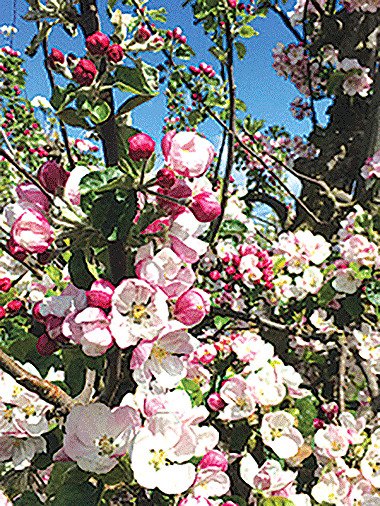
Steyning Community Orchard. May 2024: Making Space for Wildlife
May, as the blossom opens, is the perfect time to visit the Downland Orchard. Just sit beneath the trees, relax and breathe in the scent around you. But be warned; you are not alone! All around you, there are tiny, dark eyes amongst the long grass, at the bottom of the hedgerows, in the branches of the trees and looking down from the clear blue of the sky above; quietly watching you.Orchards are amazing places. They provide us with fruit to keep us healthy, bring people together, and if you need it, they offer a place of quietness, peace and wellbeing.
Traditional orchards are full of beautiful, gnarled old fruit trees that have been sensitively managed without pesticides or herbicides, where grass has been allowed to develop into flower meadows, where hedges have been left to spread and the ground, down through which the trees have pushed their roots, has been undisturbed for decades.
They are biodiversity rich, with a mosaic of different habitats; hedgerows, scrub, unimproved grassland, fallen dead wood, even ponds, dykes, and old walls.
This mosaic is important for much of the wildlife that lives within the orchard. Many bumble bee species that help to pollinate the trees need tussocky grassland for nesting and hedgerows or scrub to hibernate in through the winter, whilst some beetles which live as larvae in the wood of the fruit trees feed as adults on the flowers of tall herbs like hogweed or hawthorn and other shrubs.
Age is everything. Fruit trees age relatively quickly compared to woodland trees and as they grow old, they develop ‘veteran’ features like hollow trunks, rot holes, dead wood and sap runs, homes for over 400 species of ‘saproxylic’ (depend on dead or dying wood!) invertebrates like stag beetles, and chafers. Rot holes provide nesting sites for bats like Noctules and hollow trunks can be home for Lesser Spotted Woodpeckers and Little owls.
The community orchards in and around Steyning are young. The first trees in the Downland Orchard were planted in 2017, and it has a long journey to travel before it becomes as rich in biodiversity as some of our traditional orchards but importantly, it will change in character as the trees mature and different habitats for different creatures will be created along the way.
Even now it is enhancing the natural environment around it. The blossom around you is an important source of nectar for pollinating insects including bees, hoverflies and butterflies. The hedgerows which have filled out since they were planted, provide shelter for small mammals, nesting sites and food for birds. The long grass is home to field mice and rabbits, countless beetles and bugs. This is a hunting ground for the kestrel above you. At night there are owls and bats and the odd fox or badger with a sweet tooth for fallen apples.
When we plant an orchard, we are making space for wildlife, now and in the future.
Something we need to celebrate.
Which is what we plan to do on Green Day on the 25th May, at the start of the Steyning Festival. The Community Orchard is joining together with a host of other local conservation organisations under the banner of ‘Making Space for Wildlife’ to share how and why we are all working hard to help our local wildlife survive and thrive.
Come and see us all; Steyning Community Orchard, Greening Steyning, Steyning for Trees, Steyning Downland Scheme, Abbey Road Conservation Area and Weald to Waves.

